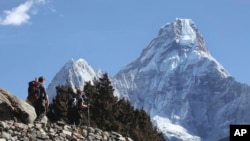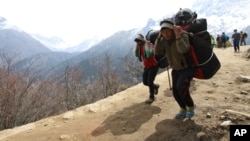After bearing witness to the gigantic mountain's two deadliest years on record, some 400 climbers are celebrating recent ascents of Mt. Everest, the first expeditions to summit successfully since the 2014 climbing season.
Although six climbers, including one Sherpa, died during the 2016 season, experts say the string of deadly avalanches and earthquakes that forced repeated evacuations of the mountain, which claimed at least 40 lives over the past 48 months, may not be a thing of the past.
“It is shrinking,” Dr. Nima Namgyal Sherpa, an Everest expedition organizer, told VOA’s Tibetan Service via satellite phone from the Nepal-side Everest base camp.“It's melting every year.”
While climbers and expedition organizers have long said there are good years and bad years, lucky seasons and unlucky ones, scientists and locals alike now say the mountain's environmental conditions have been irrevocably altered.
Norbu Tenzing Norgay, son of the first man known to have summited alongside Sir Edmund Hillary, Sherpa Tenzing Norgay, says some glaciers in the region have undergone such extensive melting that crevasses are nearly too wide to traverse.
“My brother was on a mountain recently where it was normally full of snow, and he said he wasn’t going back because there wasn't enough,” Norgay told VOA. “He had to use more ladders to cross those crevasses.”
“Last year around this time, it was much colder, but this year it is unusually warm," said Dr. Nima Namgyal Sherpa, who has spent time on the mountain for each of the past six seasons.“Usually we have these streams coming down in the end of May, but now it comes quite early for the season.”
Satellite data
Joseph Shea, senior glacier hydrologist at the Kathmandu-based International Center for Integrated Mountain Development, says satellite data that measures surface height change shows surface lowering of nearly one meter of ice per year. Last year, an international research team lead by Shea predicted that 70 to 99 percent of Everest glaciers would disappear by 2100, and that the melting has reached an unstoppable point.
“The glaciers there are in retreat, so we’re losing area every year,” he told VOA Tibetan.“But more importantly, we are losing volumes.
"Even if you stop emitting all the greenhouse gas and climate stops changing today, you’ll still have glacier losses because the system is now out of balance, it's out of equilibrium,” he added.“So, even for the next 150 years, the glacial retreat will continue without any additional forcing.”
Long term, far-reaching consequences
With Chinese scientists reporting temperatures on the Tibetan Plateau rising at a pace of four times the global average, researchers expect glacial runoff to cause widespread regional flooding, followed by long-term droughts, as ancient bodies of ice disappear or become drastically reduced.
Sherpas and other Himalayan communities will be the most vulnerable to such disasters.
“If lakes burst above the villages in the Everest areas between 12,000 to 13,000 feet, there are villages all the way down the streams that will be wiped out,” said Norgay, describing high-altitude lakes of glacial runoff appearing throughout the region.“The danger is very real."
According to the Chinese Academy of Science, an estimated 1,100 glacial lakes have appeared since the institute's first regional inventory of inland bodies of water, which took place in 1990.While most runoff lakes are dammed by unstable mountain slope debris, small outbursts have occurred, most notably in June 2015, when a small earthquake in India triggered an outburst in Bhutan.
“Our glaciers are melting, causing flashfloods and landslides, which in turn cause disaster and widespread destruction in our country,” said Bhutanese Prime Minister Tshering Tobgay in his March TED Talk.
In 2014, a village in Nepal was reportedly buried by a landslide, claiming 150 lives.
According to Norgay, who is vice president of the San Francisco-based American Himalayan Foundation, climatological changes on Everest are impacting agriculture.
“The way it really affects our people, whether they are Tibetans or Sherpas, is that our crops ripen much later now,” he said, explaining that potatoes harvested in recent years have tasted differently, and that the monsoon season is delayed.
“I’ve seen this firsthand up in the Everest area where my family is from.”
Once glaciers are gone and lakes of runoff begin to burst, consequences will reach far beyond the Himalayas.According to International Center for Integrated Mountain Development, one-fifth of the world’s population depends on rivers from the Himalayas and Hindu Kush region.
Yeshi Dorje is a correspondent for VOA's Tibetan Service.
CLARIFICATION: An earlier version of this article said satellite data showed at least one square meter of annual shrinkage. Satellite data shows surface lowering of 1 meter annually.









